I’m thrown back in my seat as the driver plants his foot and we accelerate away, then I’m pushed to the side as we make a hard right (still accelerating) as the speedo passes 100 miles (yes, MILES) per hour, and I’m left trying to catch my breath and attempt to take a half-decent photo over the driver’s shoulder while I’m at it.
What does this have to do with aviation photography you ask? Well, it all depends on where we are and what we’re doing. Where we are is barreling down the runway at the USAF’s Osan Air Base in South Korea. What we’re doing? We’re chasing down one of the most iconic and elusive aircraft in aviation history, the incredible Lockheed U-2 Dragon Lady (well, the driver [another U-2 pilot] is, I’m just trying to hold on and take it all in).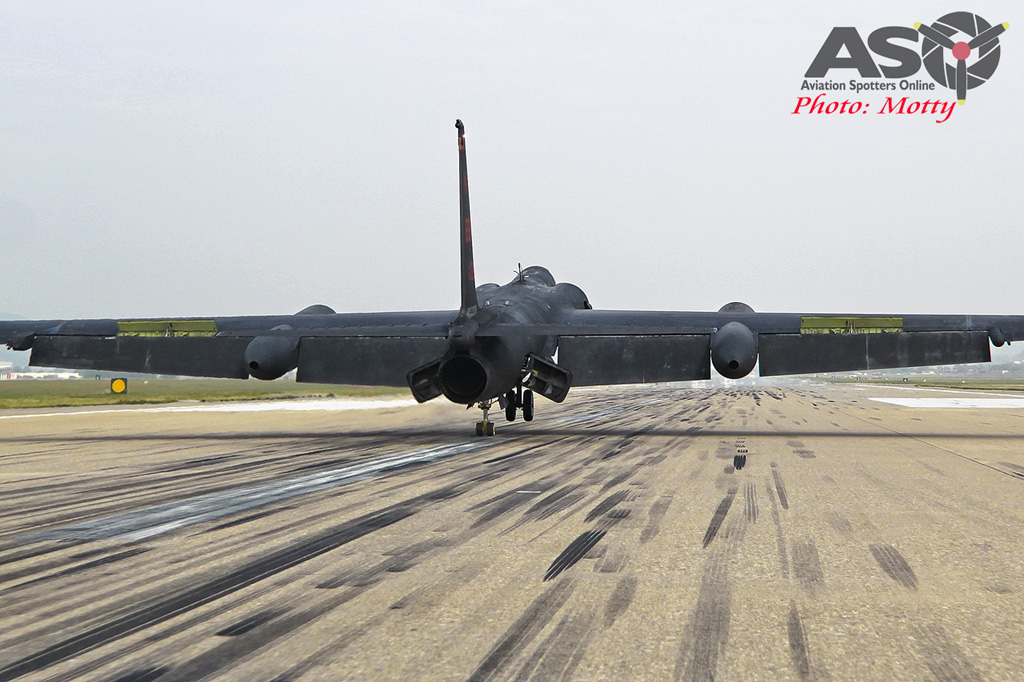
Preparing for my visit to the 51st FW at the US base at Osan, South Korea, in September of 2016 (see those articles HERE, HERE, HERE and HERE), I had hoped that, while not a part of the 51st, I might be lucky enough to also capture a few images of the U-2s which are based there with the 5th Reconnaissance Squadron (RS) as a permanent detachment of the 9th Reconnaissance Wing (RW), home based at Beal Air Force Base in California in the US. Maybe I could get them out-and-about on the taxiways on their way to or from a mission or, perhaps, from the tower if I was allowed, as I expected security around these highly sensitive machines to be pretty strict, if I was even allowed to shoot them at all, other than on the public days of the Air Power Displays held the weekend before my visit (see HERE). In reality, what I actually got to do was absolutely awesome beyond belief!
The 5th RS has a long and distinguished history, tracing its origins all the way back to the very first flying units in the US military in 1916 (being the fifth squadron of the Aviation Section of the U.S. Signal Corps at the time). In the 100 years since then the squadron has performed a multitude of roles from training, observation, medium and heavy bomber and reconnaissance, in which it continues to this day. The range of aircraft flown by the squadron in these roles is even more varied. Starting with the Curtiss JN-4 Jenny, just some of the types include the Airco DH.4, Keystone B-6, Martin B-10, B-24 Liberator, B-25 Mitchell, B-26 Marauder, B-17 Flying Fortress, B/RB-29 Superfortress, B-47 Stratojet, T-38 Talon and, most recently, the U-2 Dragon Lady.
In the earlier years of U-2 operations, the small units of personnel and aircraft which operated from locations outside the United States were most often referred to as Detachments, such as Detachment A, B or 1, 2 etc. In 1994 the 5th RS was formed at Osan, South Korea, out of what was previously known as Detachment 2 of the 9th RW, based at Beale AFB in the US. The 5th are known as the “Black Cats”, a name which has been associated with the various incarnations of the U-2 presence at Osan since 1976 and originated with Detachment H, which operated the U-2 from Taiwan in the 1960s which took the name from an establishment in a local town which personnel would often visit. And yes, the unit does keep a black cat as a mascot, although it’s a little surprising at first, when walking into such a secure environment, to see food and water bowls and a cat-bed in the corner of the office.
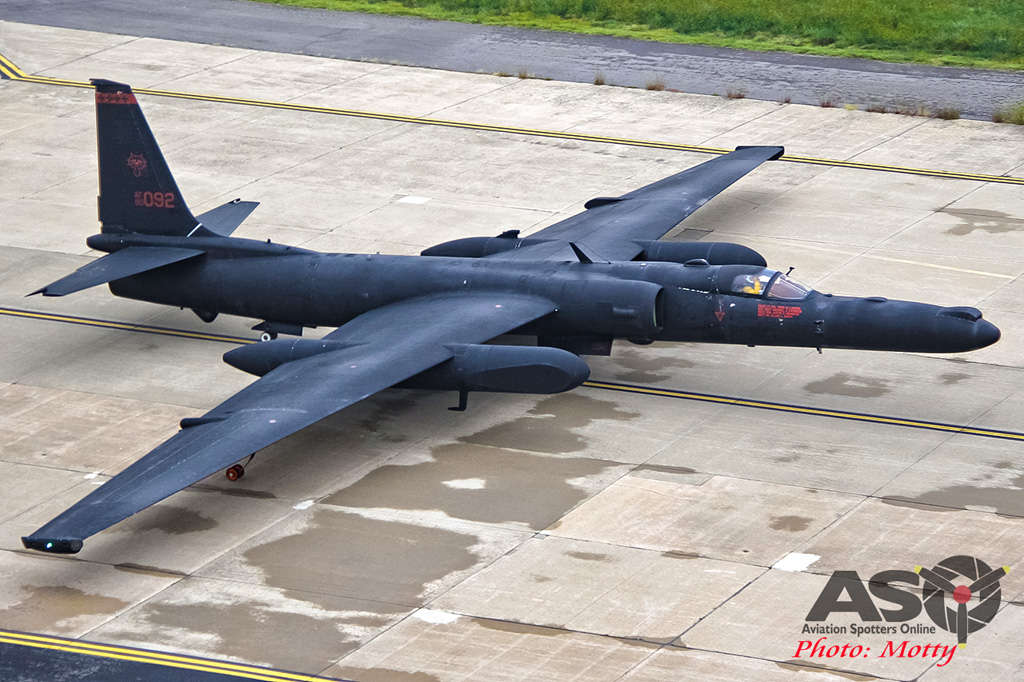
An aircraft wearing the 5th RS’ “Black Cat” marking on the tail taxies out for another mission from Osan.
The U-2 is in the unusual position of being, perhaps, one of the best known “secrets” in aviation today with most people at least recognizing the iconic machine as the archetypal “spy plane” (although the correct term is reconnaissance or surveillance aircraft). Designed by the legendary Clarence “Kelly” Johnson in Lockheed’s secretive “Skunk Works” division, first flown in 1955 and serving originally with the US Central Intelligence Agency (CIA) rather than the USAF, the U-2 has had a long and illustrious career at the forefront of the US’ and its allies’ intelligence gathering capabilities. Although it’s only relatively recently that information about the early years of operations has come to light after being shrouded in secrecy for many years. Even today (and quite understandably) most of the specific aspects of their missions are still classified, although they aren’t always military in nature with the 5th RS in particular having flown humanitarian missions to help South Korea assess environmental emergencies such as flood damage, and assisted the Philippines in analyzing the aftermath of the Mount Pinatubo eruption. NASA also operates two ER-2 versions of the Dragon Lardy for atmospheric, weather, Earth and space research from Palmdale, California.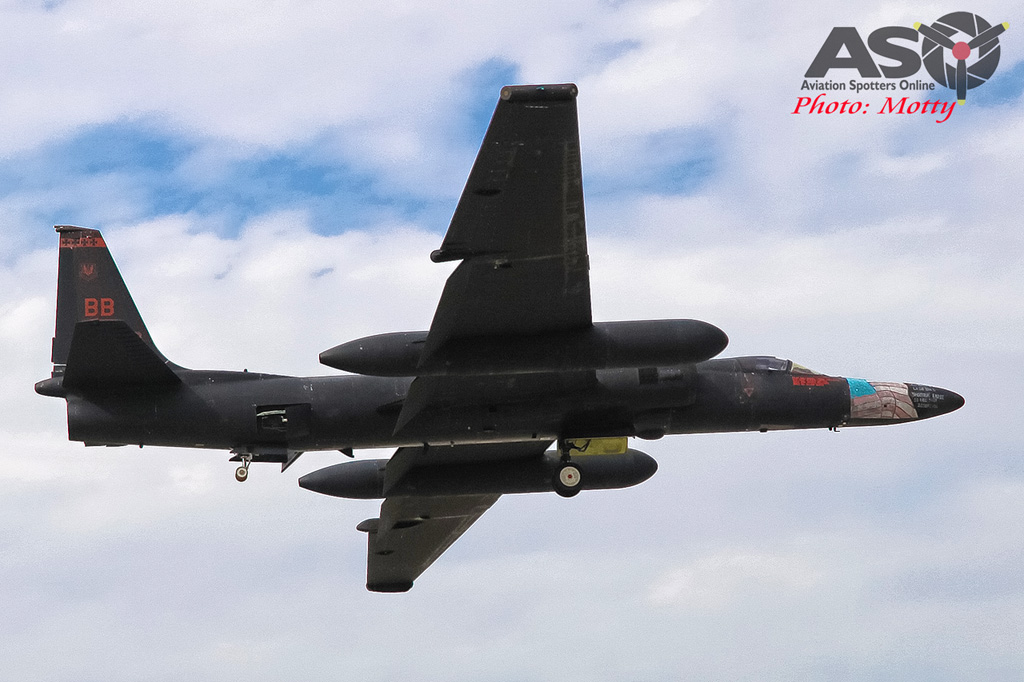
Of the U-2S versions that are flying today, most were actually built in the 1980s, so are relatively young aircraft in the context of the U-2’s overall service life, but there are around four airframes in the fleet which date back to the 1960s, and the one I got to spend the most time with during my visit was one of these; dating from 1968. The U-2Ss were originally built as U-2Rs or TR-1s (basically the same) and were noticeably bigger than the original versions of the Dragon Lady with the added feature of being able to fit two, very large equipment pods under the wings. The TR-1s were eventually re-designated as U-2Rs and, after receiving an uprated engine, the designation was changed to the current U-2S.
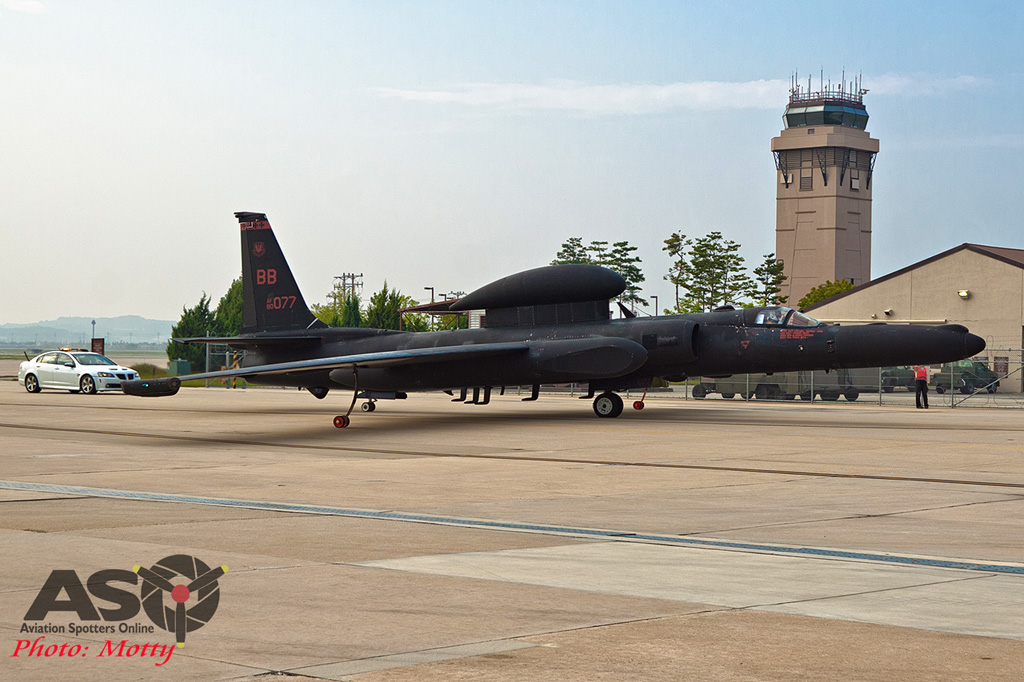
Compare the simple lines and smaller airframe of the early model U-2C above with the larger frame, pods, fairings and the extended nose of this U-2S returning from a mission at Osan.
Built to operate at extreme altitudes of 70,000+ feet (that’s over 21km high for us metrics), just about every aspect of the U-2’s performance and operations is impressive or unique. One of the most visible is how, due to the extreme altitudes and in case of emergencies, pilots are required to wear a full space suit. Even with the suit there is a risk of suffering from decompression sickness (just like divers who surface too quickly) so the pilots will start breathing 100% Oxygen and perform physical exercise an hour before their actual flight to help remove the Nitrogen from their blood, remaining connected to a portable supply right up to the point of boarding the aircraft. Even so, there have still been several instances of pilots being affected by the illness, significantly in some cases.
The 5th RS only has a few permanently assigned staff while a large number of the pilots and support crews rotate through Osan from the main unit at Beale on a regular basis, as is the case for many of the locations where the U-2 operates, so the whole program is a proud and close-knit community where everybody knows everybody else. An unfortunate side to this is that, when tragedy strikes, it affects the whole team, as everyone will have a connection to those involved. Sadly, this was the case just a week before my visit when, on the 20th of September, Lt. Col. Ira S. Eadie was killed when the two-seat TU-2S he was in crashed shortly after take-off from Beale AFB. Thankfully the other pilot survived. As a tribute to the Lt. Col, the crews at Osan applied some large artwork to both sides of the nose of one of their aircraft, in chalk, and placed this airframe on display at the Air Power Display that weekend. This was also the aircraft I spent the most time around during my visit.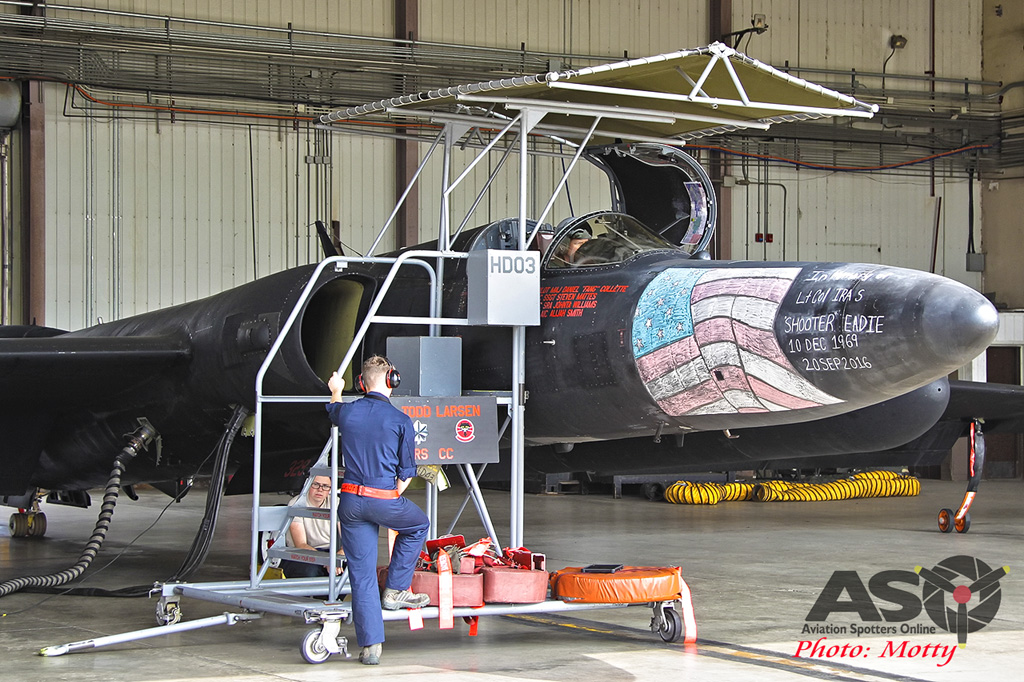
A source of pride amongst the pilots is the knowledge that, given the length of service of the U-2, only a very few people have been qualified on the aircraft. Each pilot has a number which is where they qualified in the list of U-2 pilots and that number has only recently passed 1,000. While there have been lower numbers for some other types such as the SR-71 and Astronauts, not all have operated as long, as continuously or are as “hands-on” as the U-2. They can also be confident that as they are cruising along on a mission, which can last anything up to 12 hours, they are the highest guys, or gals, in the sky, with the usual operating height being around twice that of your average long-haul airliner. Or, as my host quipped, “…other than the six people on the space station, but I can wave at them as they go by”.
So; why the cars? Many things which make it capable of sustained flight at record-breaking altitudes for long hours also make the Dragon Lady very difficult to land safely. Essentially a large glider with a jet engine; as the pilot approaches the runway, the ground effect from those huge, high-lift wings means that the aircraft actually rides on a large cushion of air and won’t land until the wings are stalled to dump their lift, something which is obviously very dangerous unless the aircraft is just about at the point of touch-down, and the unusual bicycle-style undercarriage, designed to save weight, means that the U-2 is very sensitive to cross-winds as well.
Also, while the forces on the flight controls are optimized for good response in the thin air at extreme altitude, in the dense air at low altitude (i.e. when landing) and not having a power assist system, the forces required by the pilot are very high and require large inputs to have effect. Not a great situation to have at the end of a grueling 12 hour flight while wearing a heavy pressure suit. Add to this the fact that the small cockpit and long nose mean that forward visibility is quite limited; throw in the added vision restrictions of the helmet, which is attached to the suit, and it’s easy to see why the U-2 is sometimes called the most difficult aircraft in the world to land.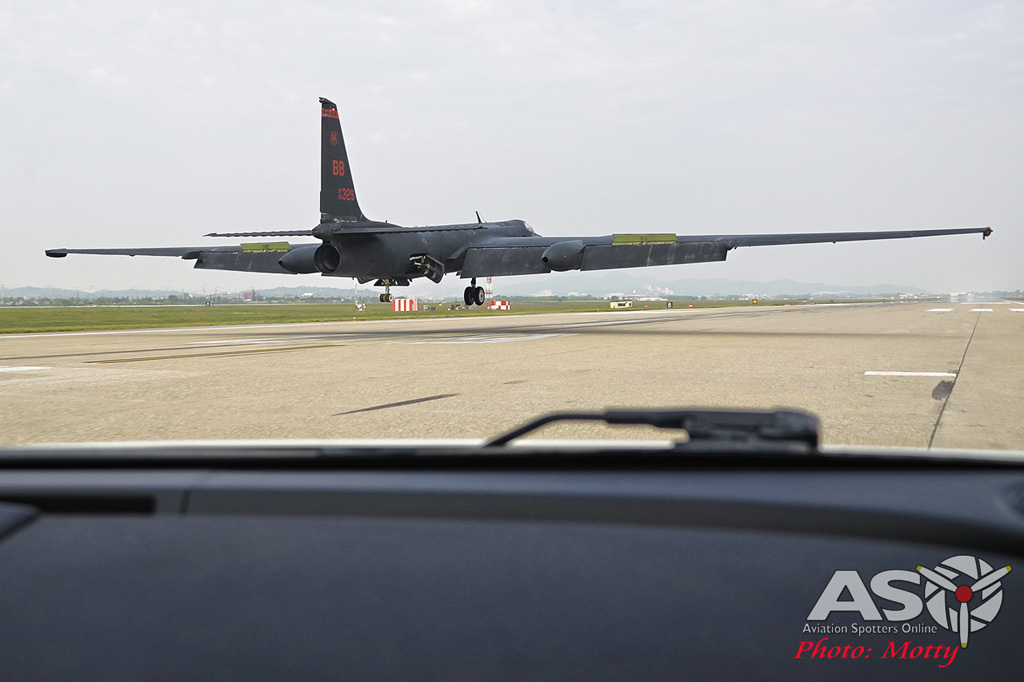
So, in order to assist the flying pilot as much as possible, one or two other U-2 pilots will chase the aircraft as it approaches to land and call out information such as height, speed, tracking, control inputs etc over the radio until the aircraft is safely on the ground.
And this is where I came in. 🙂
As I mentioned earlier, I really hadn’t known what to expect in regards to photographing the U-2s at Osan before my visit, given their security and the fact that they aren’t actually a part of the 51st FW, which would be hosting me for my visit. Things looked good right from the start though when the 51st’s PA mentioned that we would be heading down to the 5th RS on the afternoon of the first day. After getting signed in at the security gate we were escorted to the headquarters building. Now, I was probably just over-thinking things a bit too much but I have to say, it felt really strange walking into an area like that with a backpack full of camera gear, and I wasn’t quite sure where I should (or shouldn’t) be looking.
No time to worry though as one of the aircraft was being prepared and I was going to be allowed to go in one of the chase cars to watch the flight! So, with introductions and formalities taken care of, it was time to head out to the car and over to the hangar (the jets are started and taxi from inside the hangars). This was going to be a currency flight for one of the 5th RS’ staff pilots, which they must carry out regularly to maintain proficiency in basic and emergency procedures. As these flights are conducted at “normal” altitudes, the pilots can forego the oxygen pre-breathing and wear regular flight gear rather than the bulky pressure suit, which must surely be a pleasant change. With the engine started, the ancillary services disconnected and all the pre-flight checks complete, we tagged along for the taxi out to the runway.
Because of the tandem layout of the main gear, the U-2 needs stabilizing supports under the wings to prevent it from tipping over, so small, lightweight legs (sometimes called “pogos”) are fitted when the jet is on the ground and jettisoned as it takes off. They are then collected by the ground crews who also accompany the aircraft out to the runway in their pickup truck (it’s too big to be called a Ute), so, along with the two pilot’s cars, the U-2 is accompanied by a small posse` of vehicles as it heads out to take-off. Even once it’s on the runway, the take-off is not a simple process as with other aircraft, with the ground crews having to carry out final checks and prepare the “pogos” for jettison after lift-off. It also provided a chance to get photos from some very rare angles, as the jet waited on the runway.
After the U-2 took off and departed for the first part of the sortie, we waited near the threshold and watched some heavy lifters depart and the 25th FS’ A-10s doing circuit practice, to which our host from the 5th observed “now those A-10 guys sure have a cool job”, to which all I could manage was “really?” (Remember this bit for later).
The cars used for chase duties by the 5th RS are Pontiac G8s. Now, our Aussie readers are, of course, going to point out that what they really are is an Australian-made export version of the Holden VE Commodore and, yes, as a proud Aussie, I made sure to point this out. The crews seem to love them too as they have everything they need for these duties. Great power, rear wheel drive, four doors with a decent back seat (as they often take other service members along on rides like this) and good visibility (which is very important when you’re charging towards an aircraft on approach and want to keep an eye on exactly where it is). Other than the radio gear which is required to communicate with the aircraft, the only performance related change they make to the cars is to fit softer compound tyres for better grip. And I can assure you, these things get a real workout too.
As word came in that the U-2 was headed back to do some practice landings, we moved out to the end of the runway, facing it at 90 degrees so the driver can see and track the aircraft on approach, then, as the jet crossed the airfield boundary, BAM! It was on! Our driver put his foot down and we accelerated off the mark while, at the same time, making (what felt like) a hard right turn, still under strong acceleration, to follow the U-2 as it grew larger and larger in the windscreen until we were lined up to the right and slightly behind the aircraft and pacing it. As the driver passed height and other information over the radio, the jet slowly approached the ground until it gently touched down, rear wheels first. I was in the rear, left seat with the window down, trying to steady the camera against the slipstream as we kept pace with the jet, until it powered up (just outside the window) and climbed away again. That wasn’t the end of it though as our driver stood hard on the brakes to make the rapidly approaching turn-off then drove hard once again to return to our starting point to await the next approach. After a few moments to catch my breath and absorb what had just happened, I observed; “yeah, your job’s not cool at all!”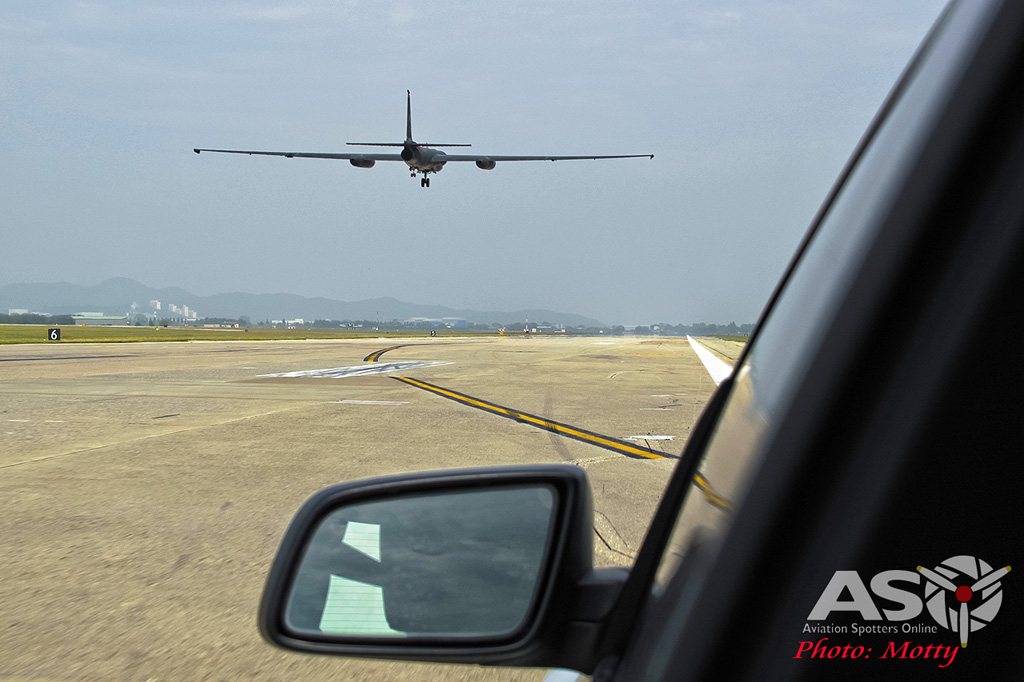
The fact that this was a training flight with several landings being performed by the pilot meant that there were opportunities to get a much better variety of shots that would have been possible from a single landing following an operational sortie so, after another couple of go’s to try and get my eye in and to get used to shooting from a fast car, our host suggested that I change seats to get some different views (he’s obviously done this before).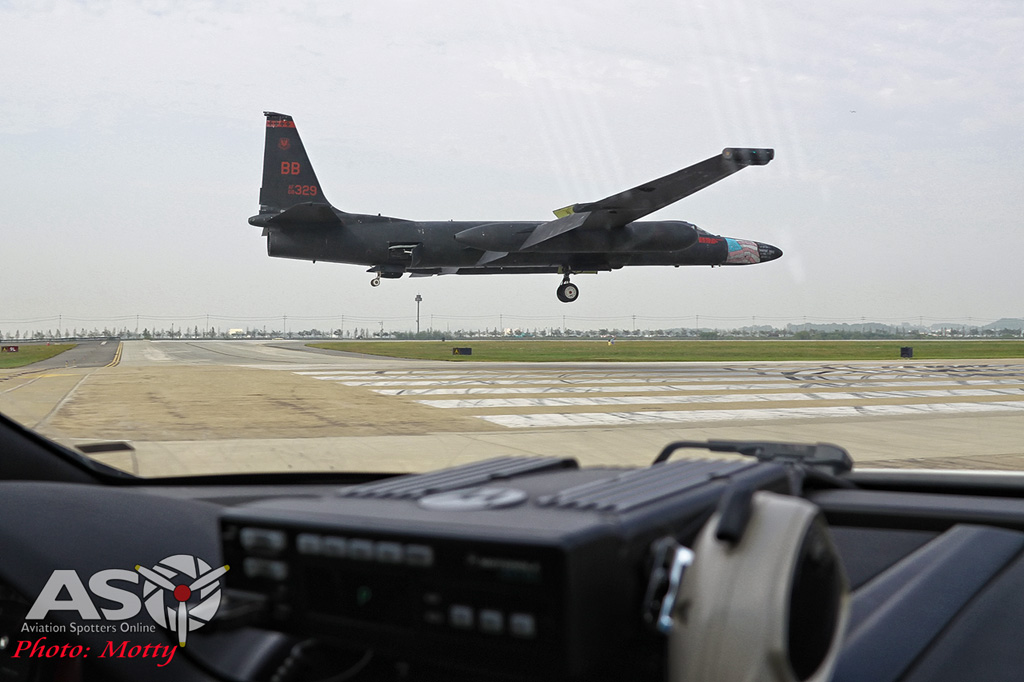
The first few landings were touch-and-go’s with the aircraft rolling along the runway for a short distance with us in pursuit before lifting off once again but, for one of the final approaches, he actually stopped the aircraft on the runway, at which point, it tipped over and rested on one of the wingtips (which are designed for this). The ground-crew were quickly on the scene to give the aircraft a quick check-over and, rather than fit the “pogos”, they simply held the wings level, one on each side, and “launched” it by hand, with the U-2 gaining stability and control authority almost as soon as it began moving. I couldn’t help thinking that surely, to some of them, it must feel a bit like launching the ultimate glider or model plane as a lot of us did when we were kids.
After the final landing, the ground-crew again gave the jet a quick check and fitted the “pogos” so that the U-2 could taxi back to the lines where all the post-flight checks and servicings were carried out.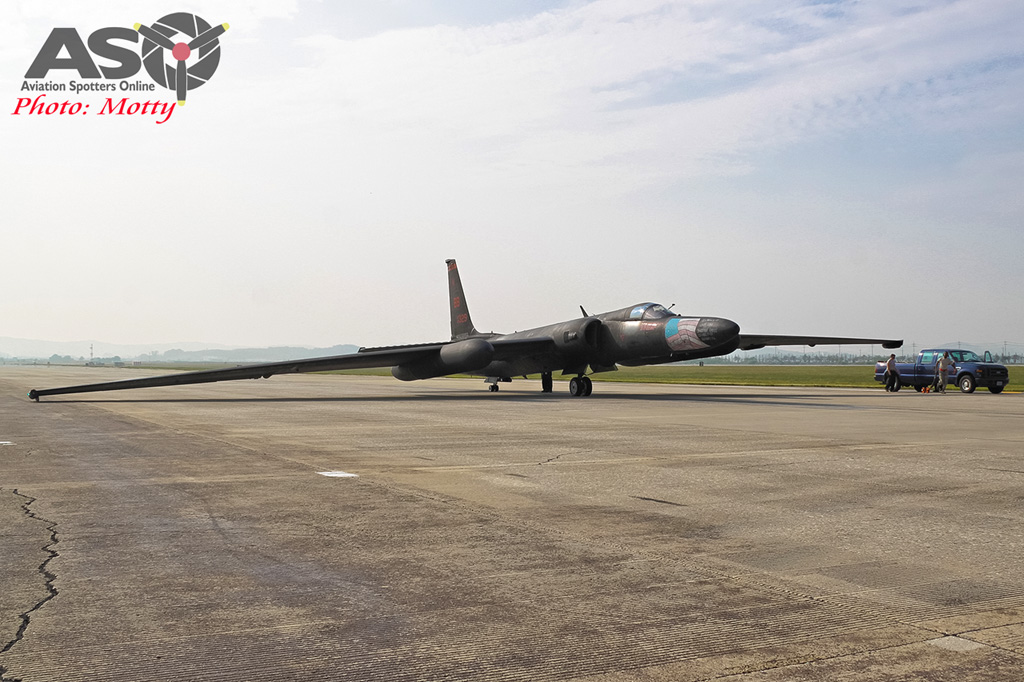
I was also given the opportunity to capture an aircraft in one of the hangars which was undergoing maintenance which provided a good example of the “modularity” of the U-2’s breakdown, with the entire nose of the jet being removed for servicing. The key to the U-2’s flexibility is how it can be specifically configured with the relevant sensors and equipment to suit the mission which is made possible by the different elements being fitted as modules, such as the entire nose, large dorsal fairings, the large underwing pods and fuselage, all accepting different packages which can be mixed and matched to suit the requirements of the sortie. You can see a bit of this in the differences between the various aircraft in the photos from my visit.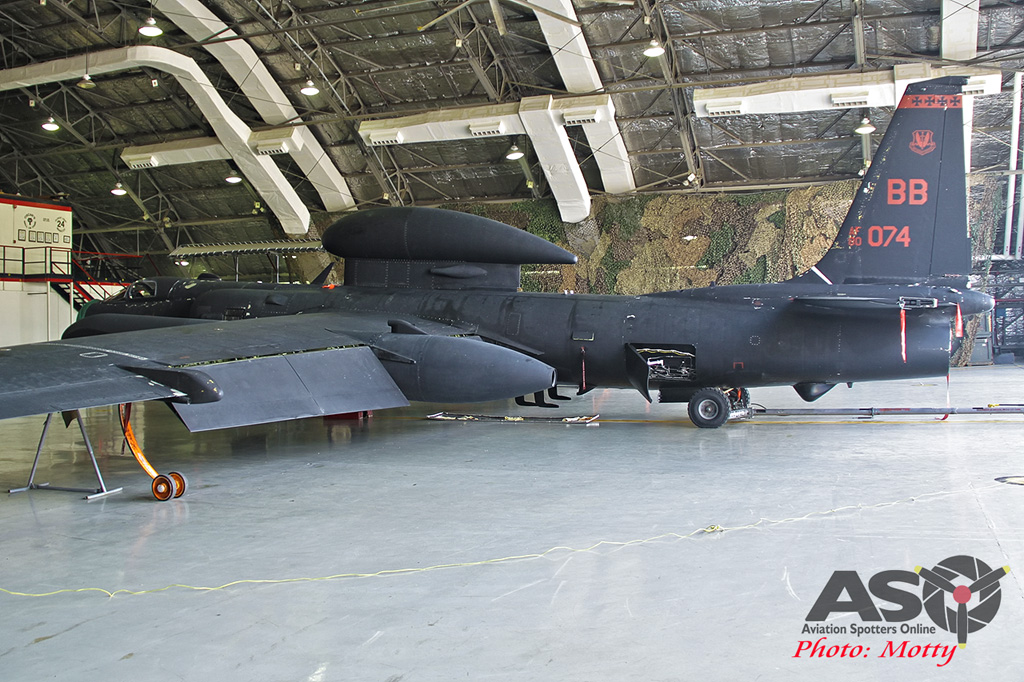
A short time later another Dragon Lady returned from an operational sortie. After this aircraft had shut down and the crews assisted the pilot from the aircraft, this time wearing the iconic space suit, I was treated to a wonderful example of the mutual respect and camaraderie that this small community have for each other when, as is tradition, the crowd of support crews gathered around and gave a round of applause for the pilot and the successful completion of another U-2 mission.
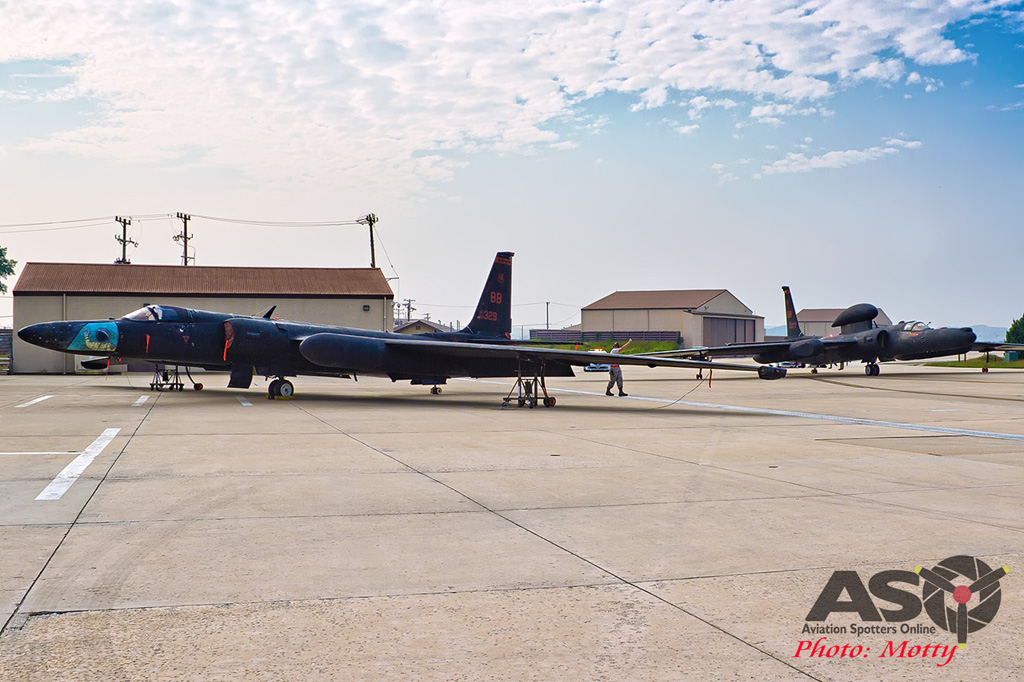
Another U-2 returns from an operational sortie past the I aircraft I had chased down a little earlier.
So ended my all-to-brief time around this legend of aviation and the men and women who continue to operate it day-in and day-out. A type first designed and flown in the 1950s yet continues to be at the forefront of the United States’ Reconnaissance and Surveillance capabilities and technology with no competitor in its class. Although there has been talk of retiring the U-2 and replacing it with other, non-piloted platforms, this has (so far) not proven possible, with the performance, flexibility and capability of the Dragon Lady remaining second-to-none and, with recent investigations by Lockheed revealing that the current fleet has only accrued about one fifth of their total fatigue, there is a lot of life left in the Dragon Lady yet. 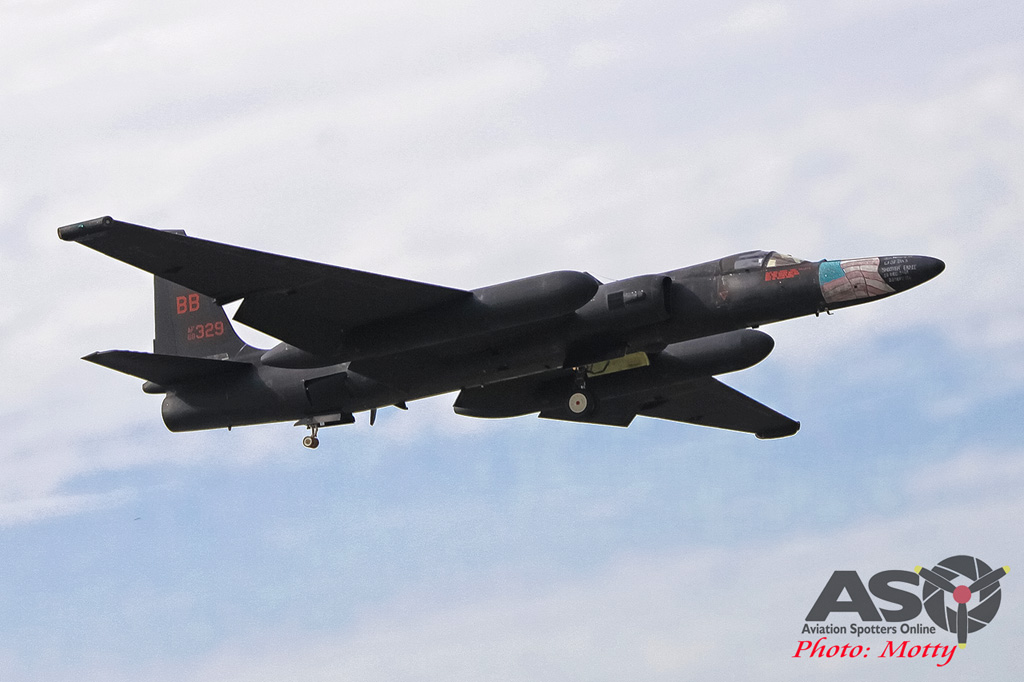
I have been very lucky to have many incredible experiences and opportunities over the years. Flights in various types, the chance to visit other countries and see some rare and interesting aircraft, every single air-to-air photo opportunity and many others, and I sincerely appreciate every single one and the many people who have made them possible. But I have to admit that this was one of the most amazing and something that I never thought I would have the opportunity to experience. My sincerest tanks to the men and women of the 5th RS and 51st FW for making this visit possible, being so accommodating and helpful and making it such an enjoyable time.
Oh, and for the record, our host for the afternoon finally relented and admitted that, yes, he does have a pretty cool job after all.
Motty.



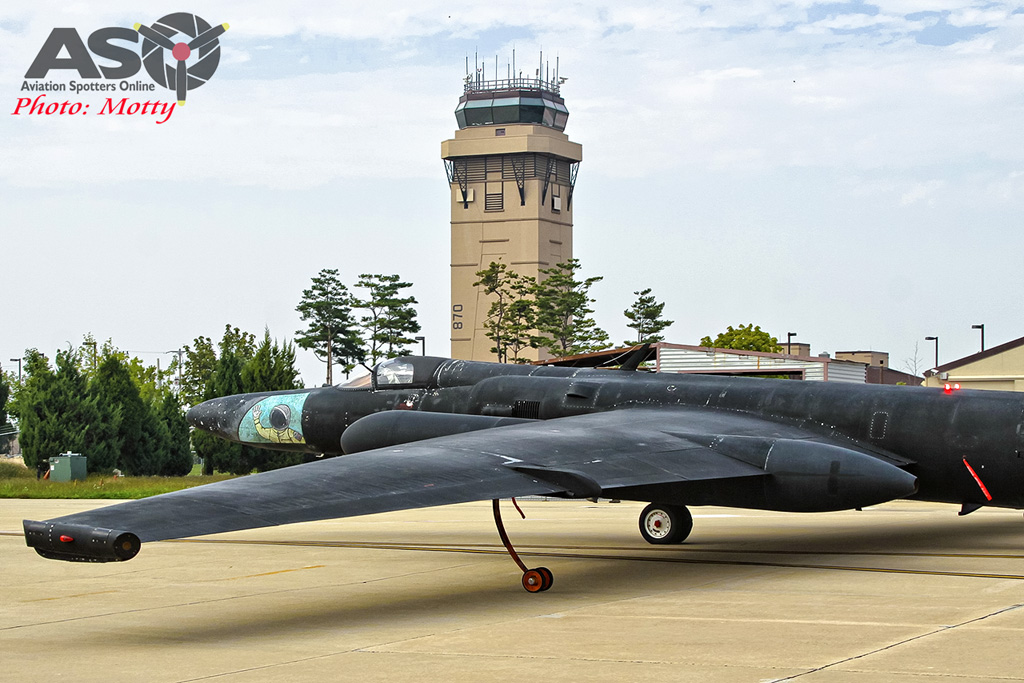



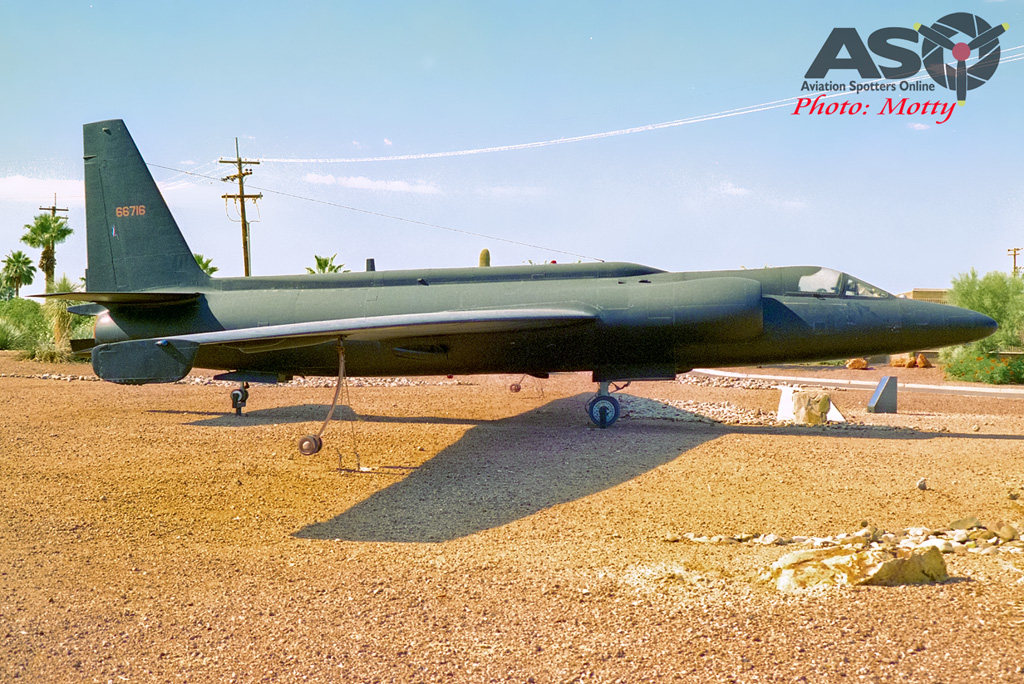

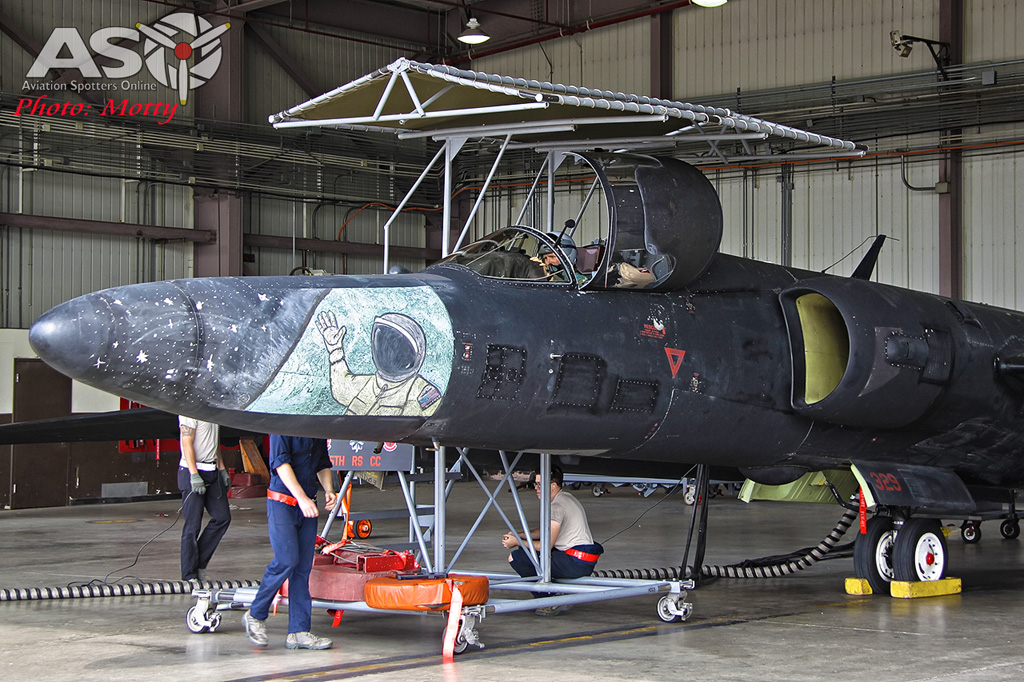

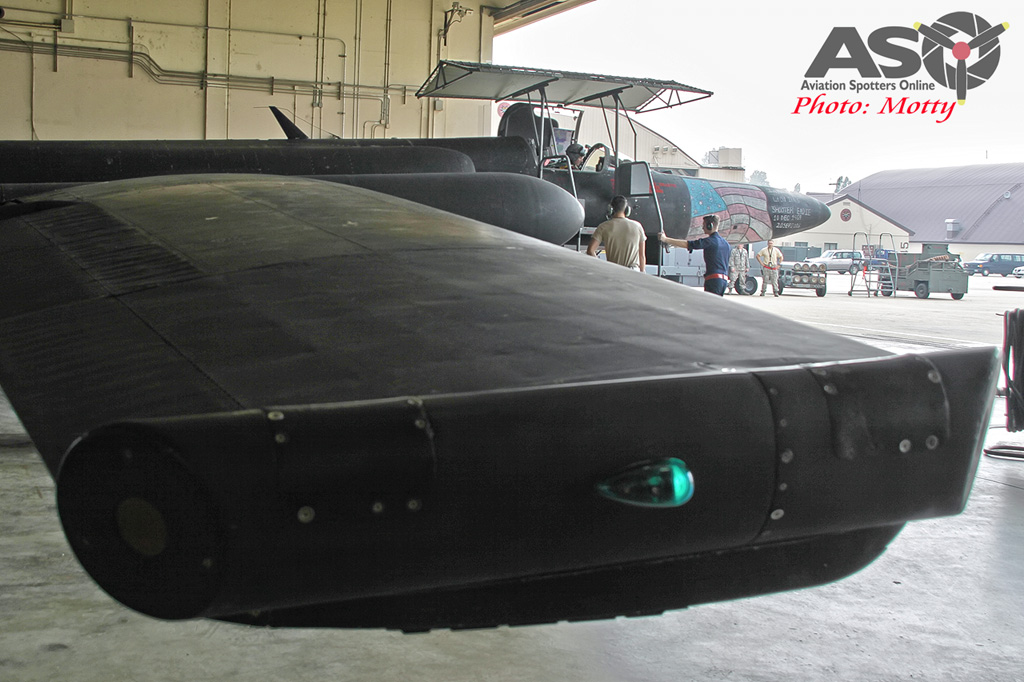
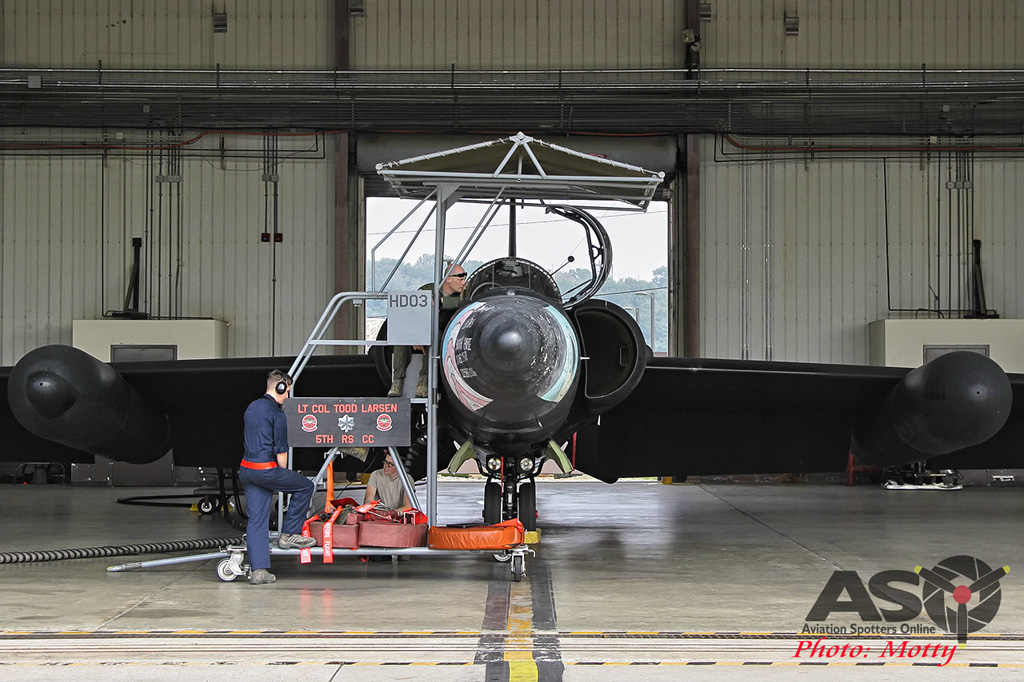
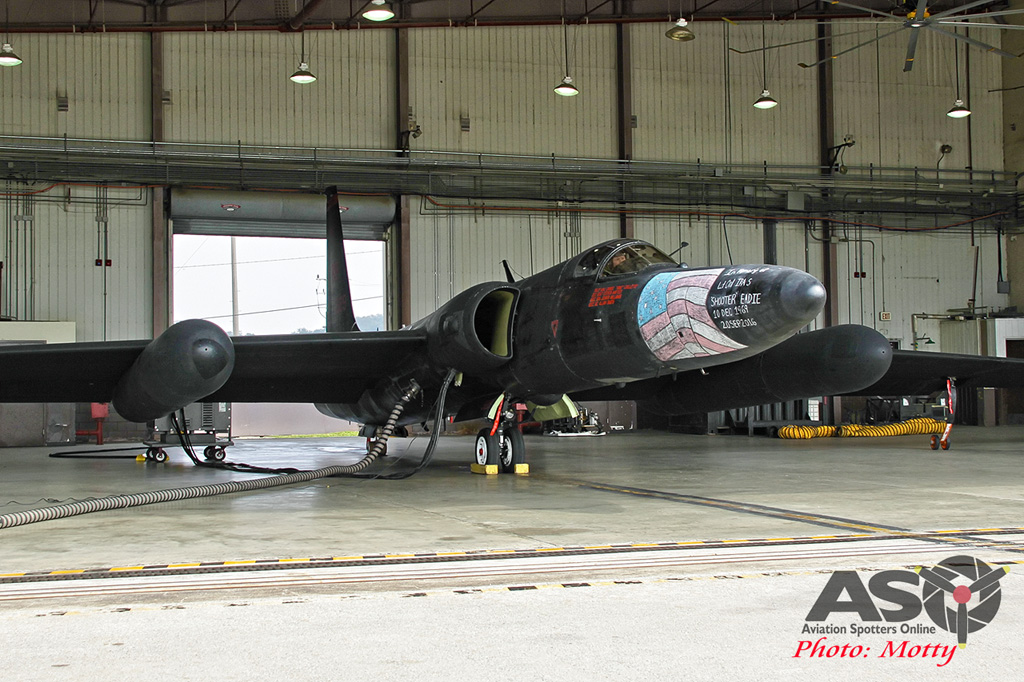

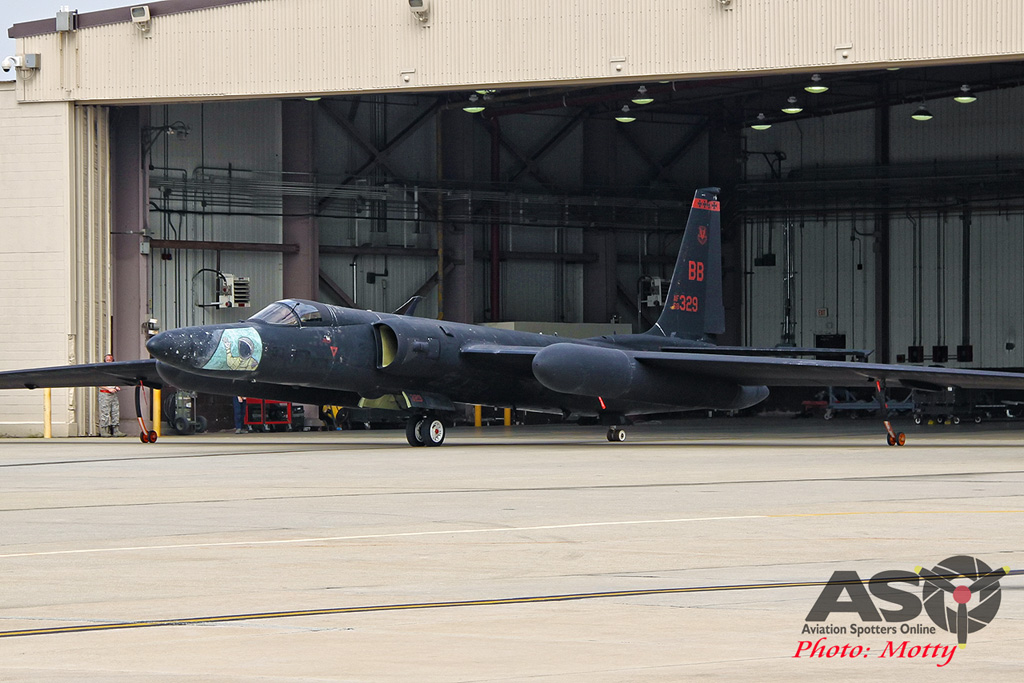
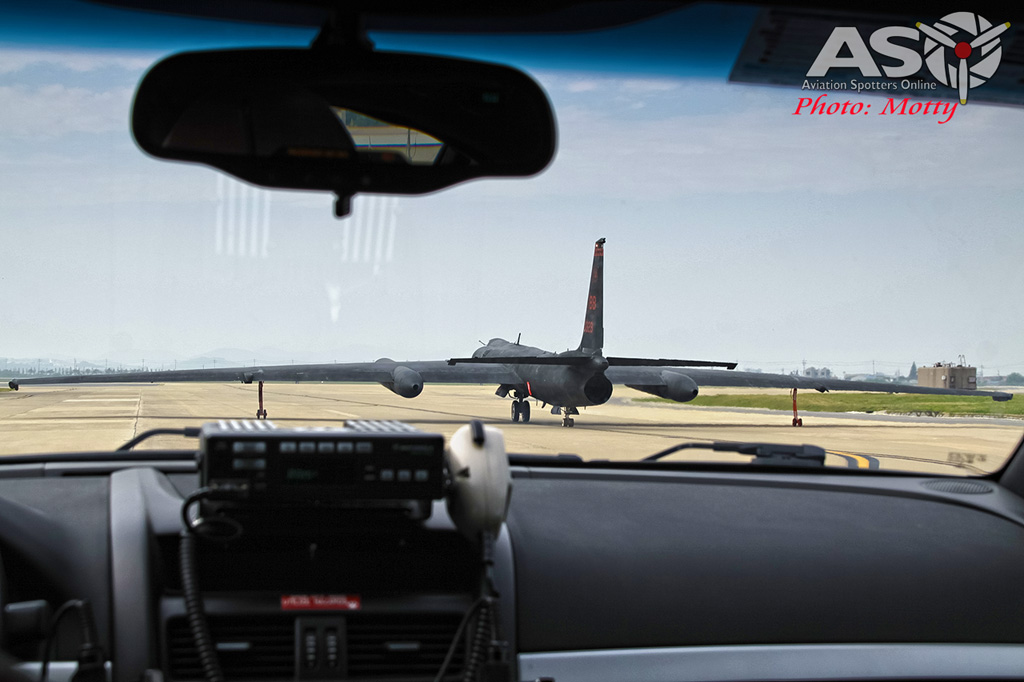


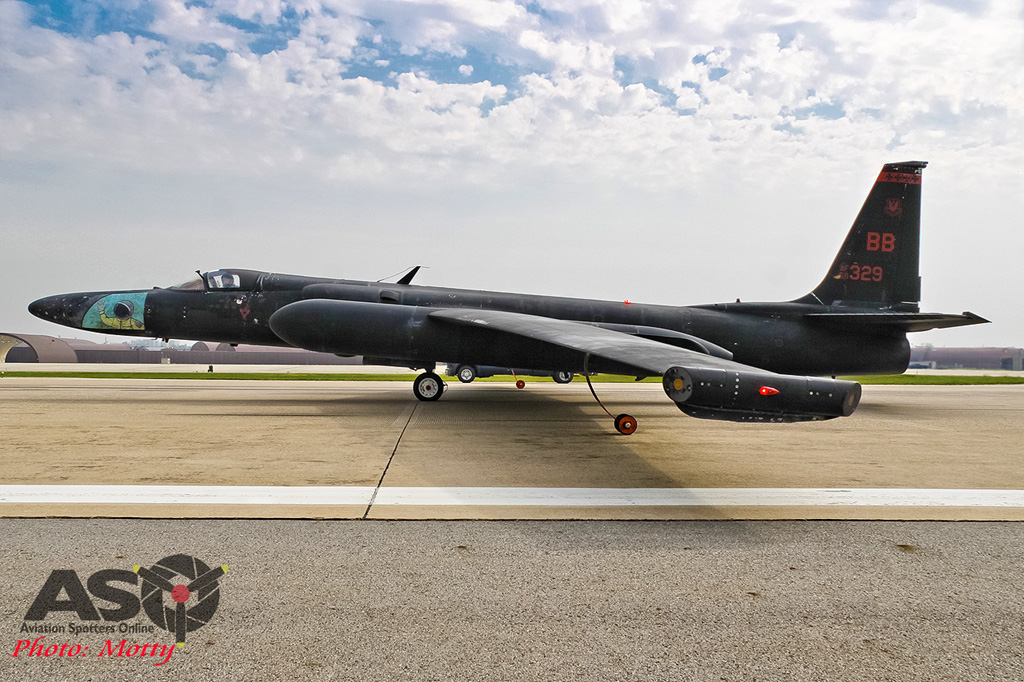



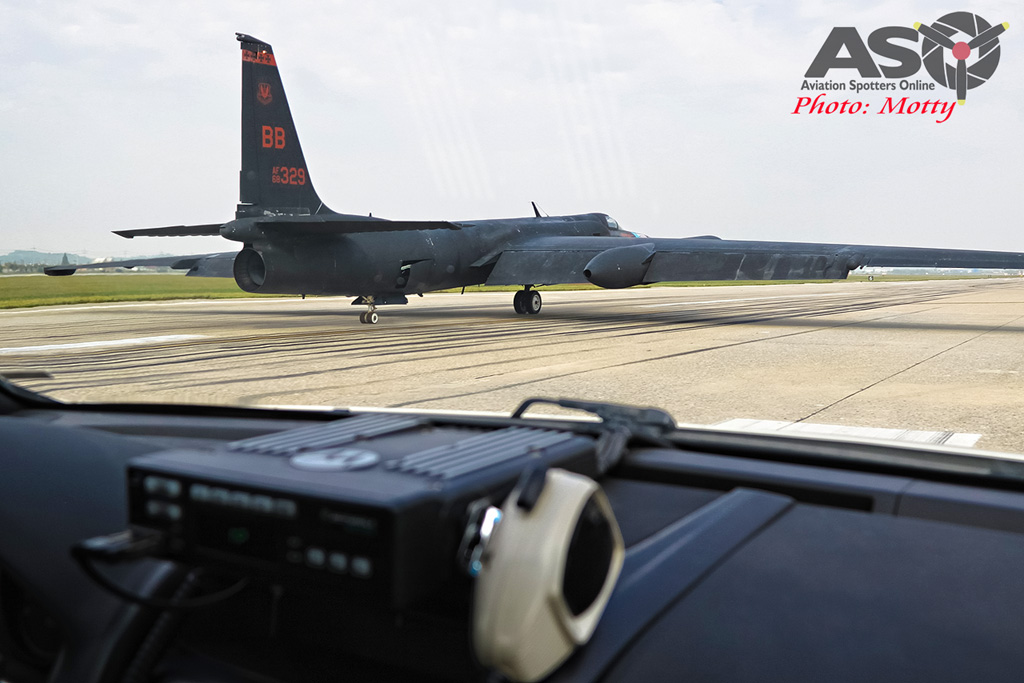
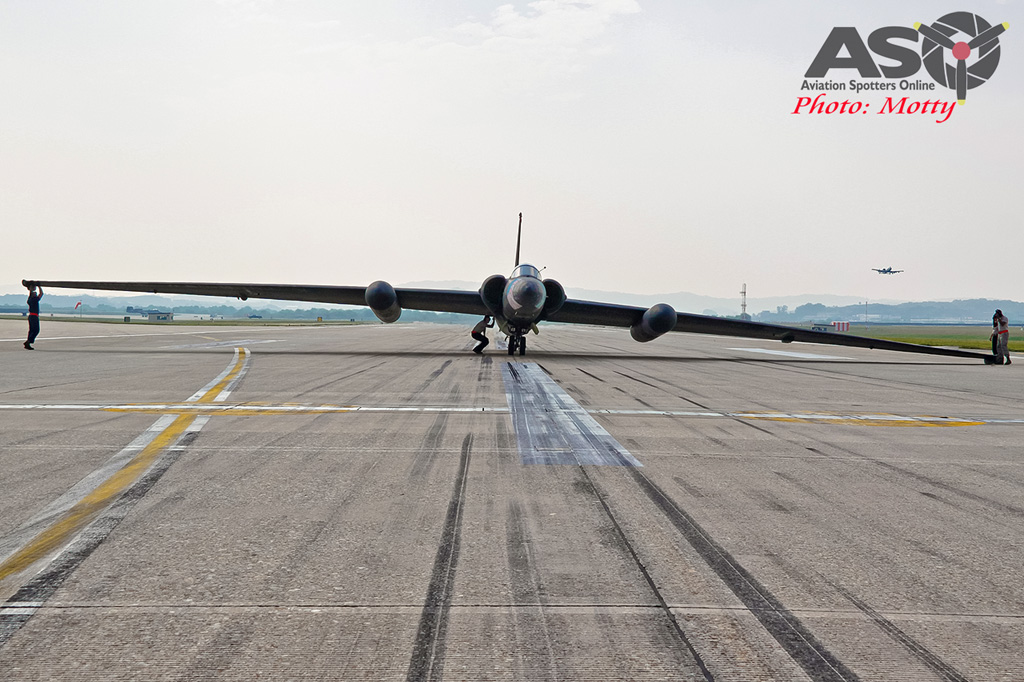
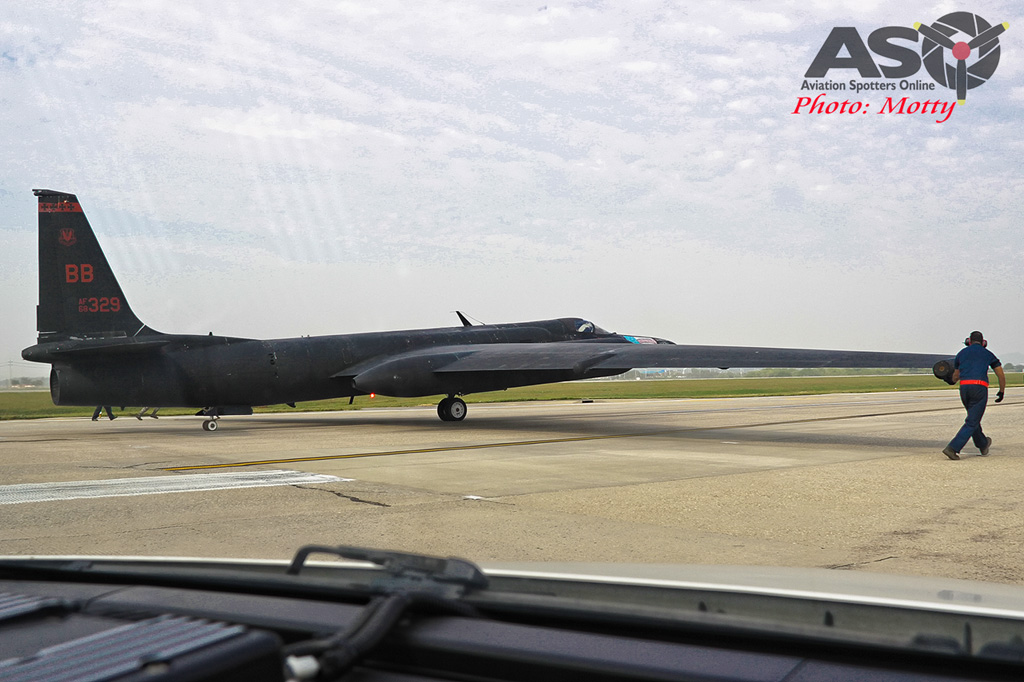
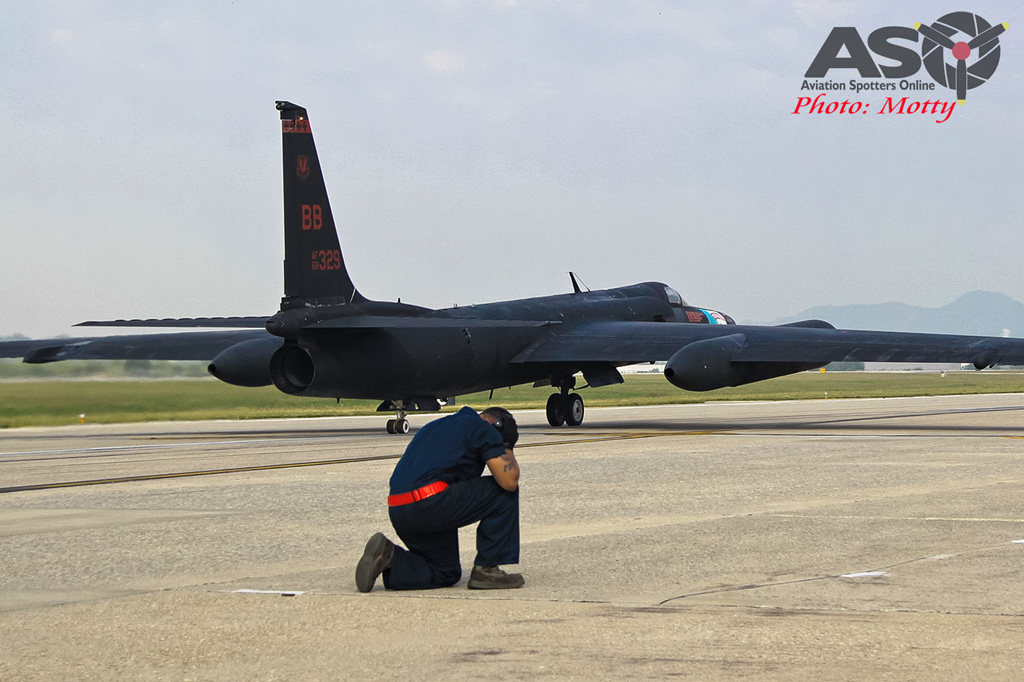



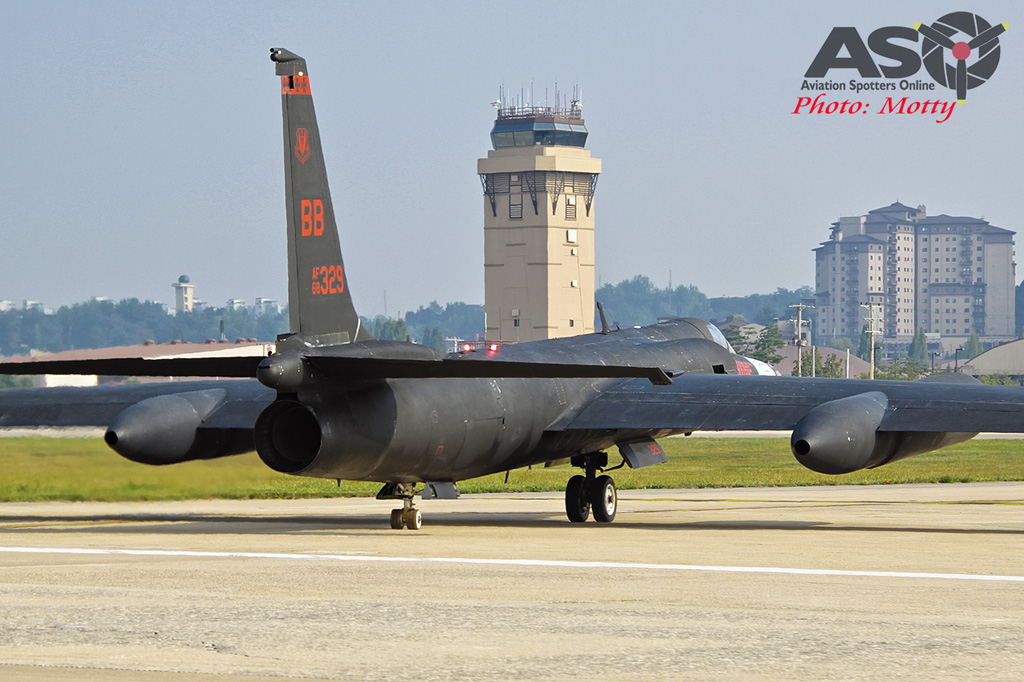
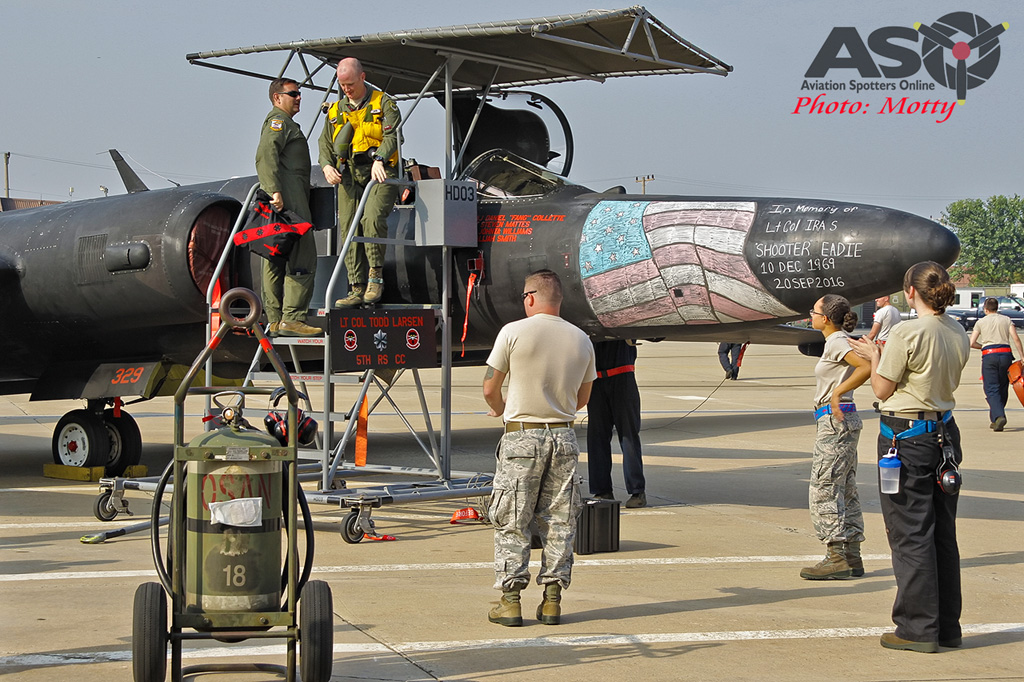

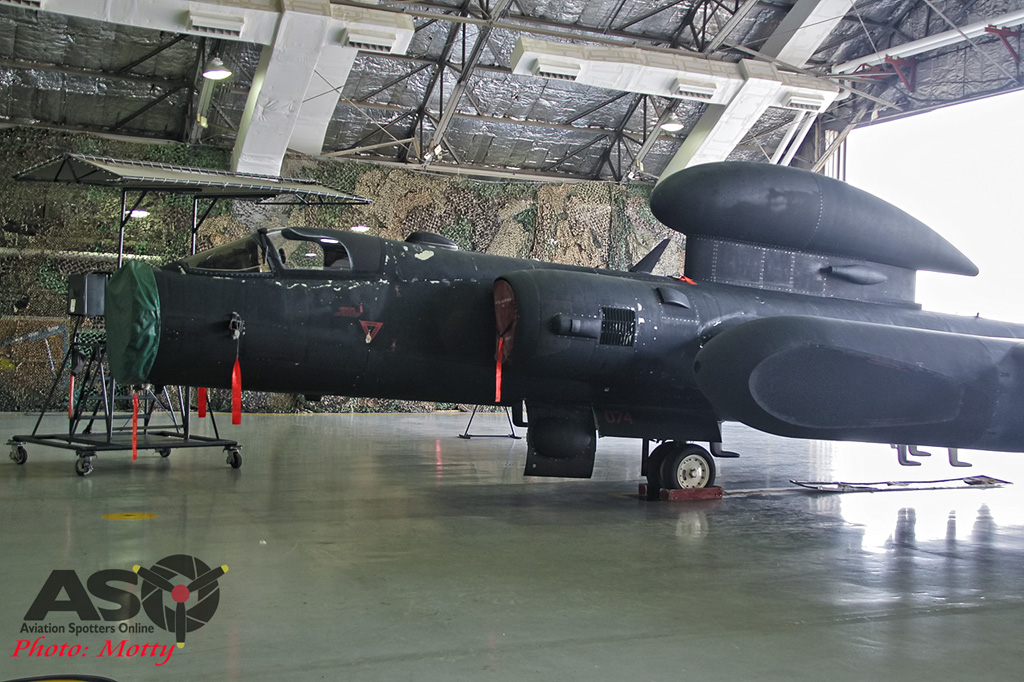
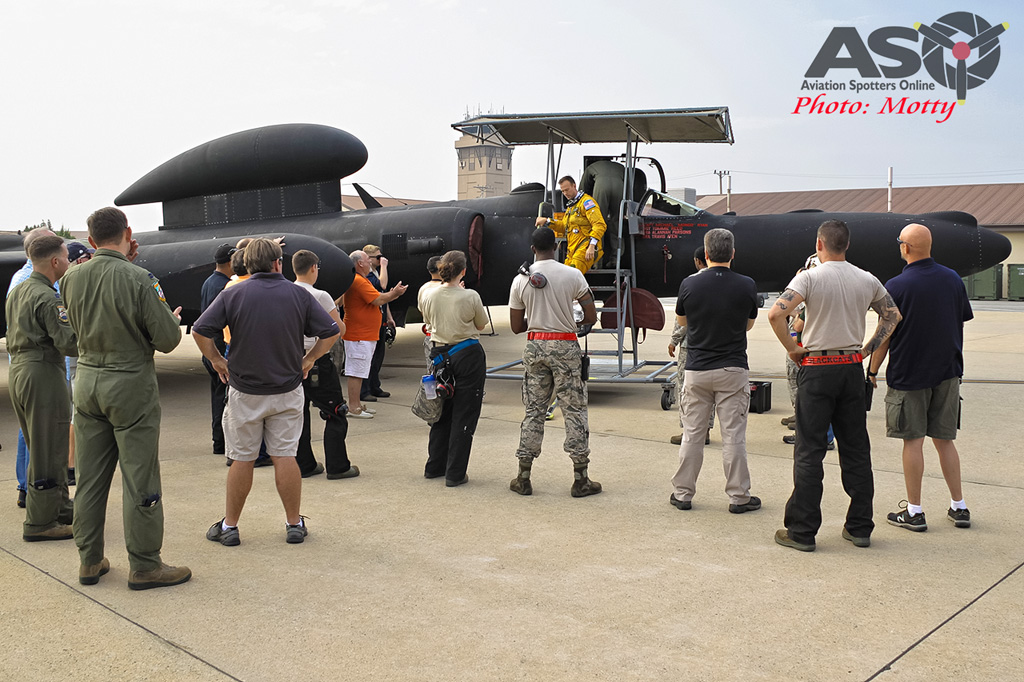


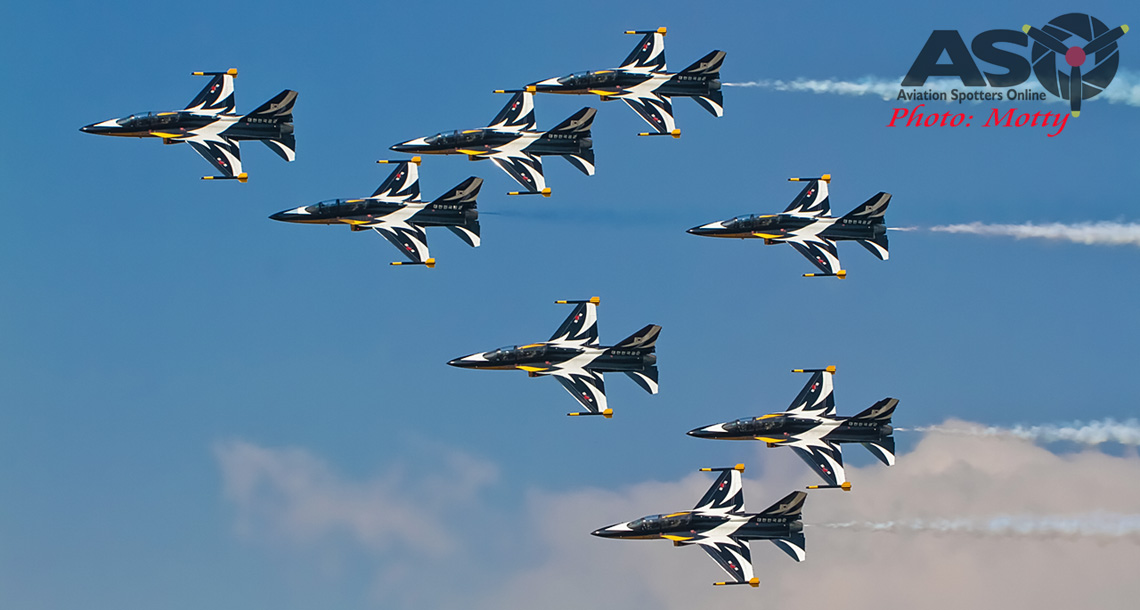
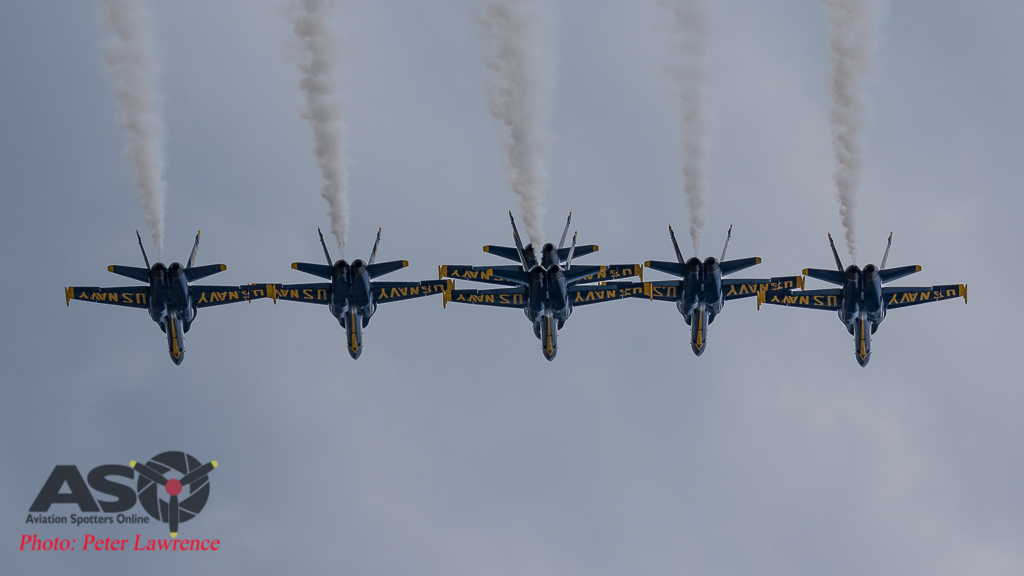
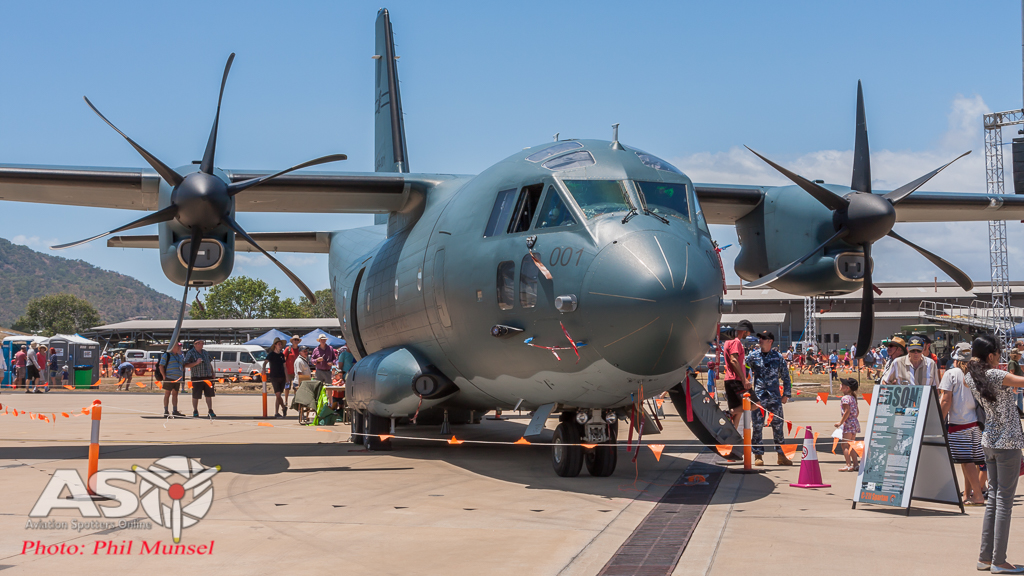
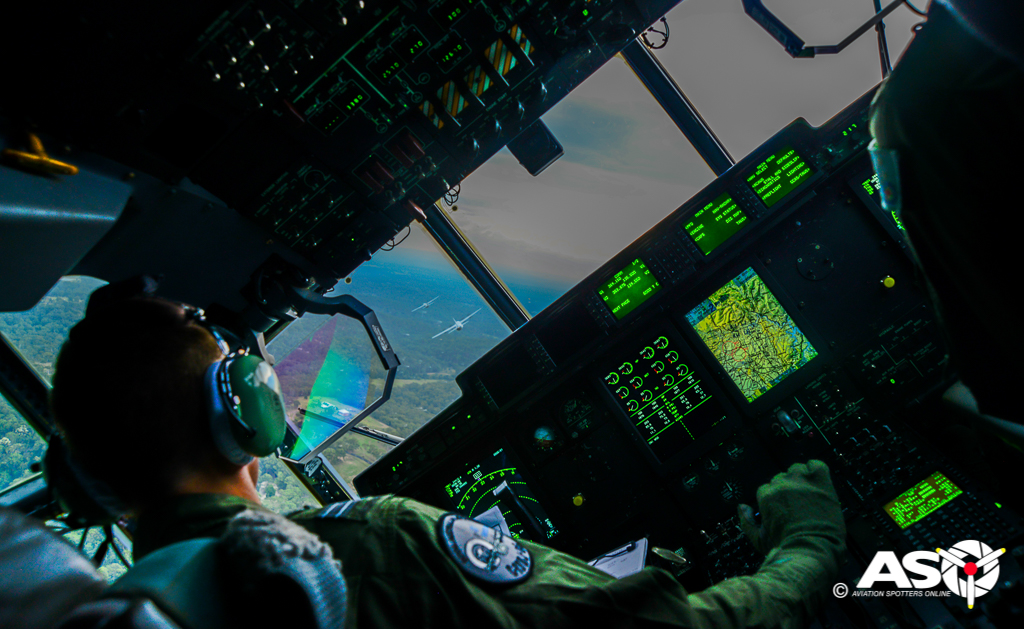





I was a USAF photographer stationed in Guam in 1965 and some guys came from the 4080 SRW in Tucson. We were processing film off the B-52-52s. I got along well with them & surprisingly I was assigned to the 4080 Strategic Reconnaissance Wing when I left Guam. I processed a lot of film off of the U-2 and I also filmed a few landings with a 16mm movie camera out of the side back window of a Ram barged Dodge Wagon.
G’day Gene, Wow, I bet you’ve got some great imagery from your time in service. -Motty.